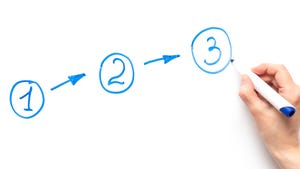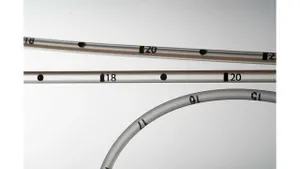Extrusion Q&A: Gear pump questions get answered
More than 900 processors registered for our last Extrusion Expert webinar, and they brought their toughest questions with them. Engineering consultant Allan Griff, the star of the webinar series, fielded their questions with aplomb. Here we'll start sharing some of those answers, with more soon in upcoming articles.
April 8, 2010
, the star of the webinar series, fielded their questions with aplomb. Here we'll start sharing some of those answers, with more soon in upcoming articles. To register for the next (April 14) webinar, just use this link. Have more questions? Contact Allan directly via his website.
Q: How do I calculate the efficiency of a gear pump?
Griff: You need the volumetric displacement of the pump, which should be supplied by the pump maker. Make sure it is displacement per rpm for both gears. Then multiply by melt density to get weight displacement - for example, if volumetric displacement is 160 cc/rpm and melt density is 0.75 g/cc, then weight displacement is 0.75 x 160 = 120 grams per rpm. Next, apply this to a production situation - multiply by actual pump rpm to get theoretical output in weight per hour. For example, if running the pump at 50 rpm = 3000 rev/hour x 120 g/rev = 360,000 g/hr = 360 kg/hr = 793 lb/hr.
Now measure actual output and take it as a percentage of theoretical. For example, if actual output is above 90% (714 lb/hr), that is very good. Output between 80-90% (634-714 lb/hr) is less efficient and you should watch the deterioration rate. If output is between 70-80% (555-634 lb/hr) the pump is not doing a good job, and if below 70% (555 lb/hr) there is so much internal leakage that it is probably better to remove the pump and get it fixed or replaced.
Options include rebuilding gears, refinishing sealing surfaces, and complete replacement. Keep in mind that a pump run above its pressure limits can bow out (clamshell) and appear inefficient even if the gears are in proper condition.
Q: Can you use gear pumps in blown film?
Griff: They are not very common, but can be used. Much film is processed in a high-pressure operation (4000 psi or more) because of the spirals, narrow lip gaps and use of high-viscosity resins for strength. Therefore, leakage may be a problem if the pump is not selected to withstand such high pressures, or is otherwise compromised by contaminated or distorted sealing areas. Also, the sides may bow (clamshell) if not thick enough, which will reduce the efficiency and precision of the pump. The pump makers might have more to say on this subject.
Q: Are there any gear pumps that are NOT lubricated by reverse polymer flow?
Griff: This was done many years ago with mated fluoroplastic bearing surfaces to allow pumping of PVC and other heat-sensitive materials, but I haven't heard anything since. Ask the makers of gear pumps, and if they say it can be done, make sure you know the heat stability of the material that was used. If you put enough stabilizer in PVC it will take a lot of heat, but its cost will be excessive.
Q: If gear pump suction pressure is set too high, is it possible to cause leaking?
Griff: I wouldn't expect this at moderately high suction pressure (e.g., 1000 psi), but if it was up at 1500 psi or more, that increases the pressure at the screw tip, and there is a greater chance of a leak at the screener, especially if there was already an imperfect seal there. In that case, even if there were no leaks, I would ask why the suction pressure is run that high, since 800 psi is a more typical value.
Q: Are there instances where you would place the gear pump prior to the screens?
Griff: I might do this if I was using clean material and wanted fine screens, and the extruder wasn't able to push through the increased resistance of the contamination collected on the screens. If the screens were after the pump, then the pump takes over the job of pushing through them. This is rare, however, as the usual order has the screens before the pump to protect it from hard contaminants that might jam or chip the precisely-machined teeth.
I've heard of a compromise system with two screen positions -- the first one collects the contaminants in the melt as it leaves the screw (and also protects the pump) and the second is located after the pump and just before the die, to collect any particles that have been produced by degradation between the first screens and the die (i.e., in the pump, mixer and adapter).
Q: Can a gear pump be used with very high filler content, or will pressure be a big problem?
Griff: A gear pump should work with fillers, provided the pump is capable of handling filled materials (abrasion resistant materials, particles small enough). Talk with the gear pump makers and see who has done it before. The pressure is the resistance of everything after the pump, and may be high (5000 psi or more) as most fillers raise viscosity, but pumps come in light-medium-heavy constructions, and the heavy ones can take 10,000 psi or more. It's important to get the right pump, but once that is done, I am more concerned with abrasion.
About the Author(s)
You May Also Like


